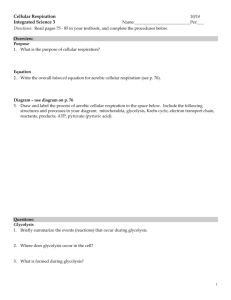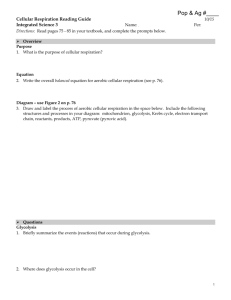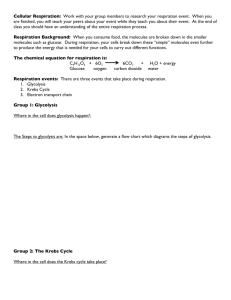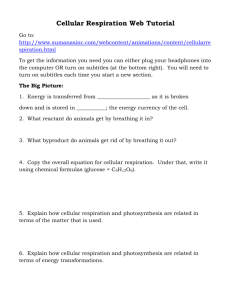Cellular Respiration and Photosynthesis review game
advertisement
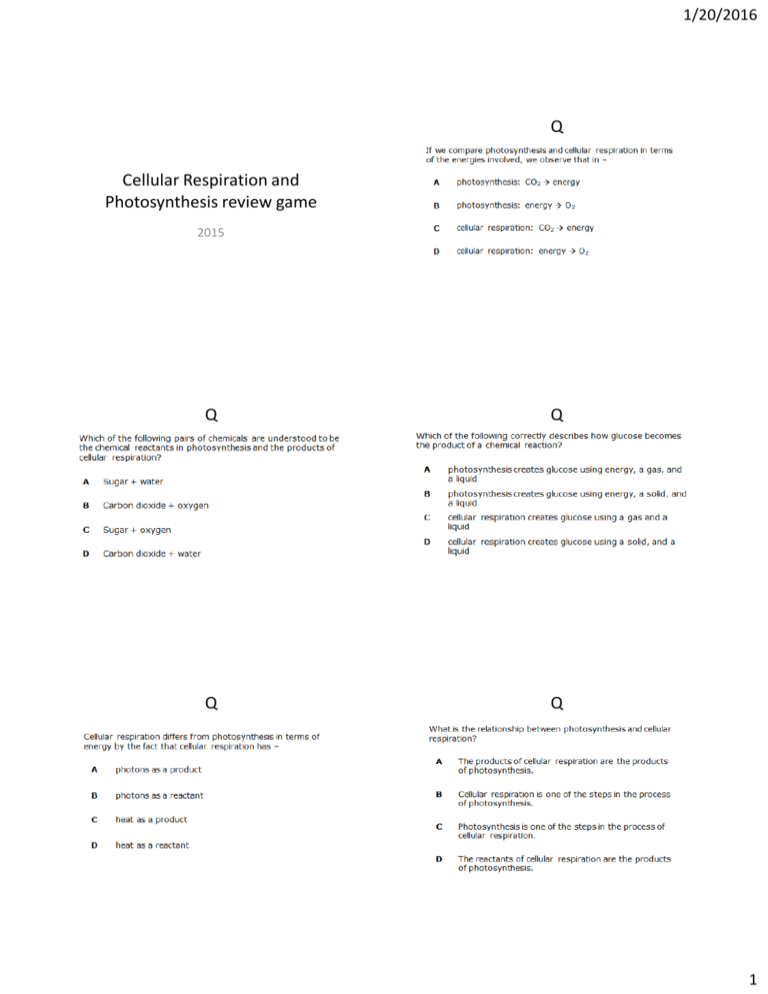
1/20/2016 Q Cellular Respiration and Photosynthesis review game 2015 Q Q Q Q 1 1/20/2016 Q Q Q Q Q Q 2 1/20/2016 Q Q Q Q Q #1 _______________________ is the first step in cellular respiration that begins releasing energy stored in glucose. • A. Alcoholic fermentation • B. Lactic acid fermentation • C. Glycolysis • D. Electron transport chain 3 1/20/2016 #2 The carriers for energy and high energy electrons during GLYCOLYSIS are ________. • A. ATP • B. NADH • C. FADH2 • D. NADPH #4 Name the 3 carbon molecule produced when glucose is broken in half during glycolysis. • A. pyruvic acid • B. lactic acid • C. carbon dioxide • D. citric acid #6 How many ATP molecules are added to get glycolysis started? _________ Since glycolysis produces 4 ATP molecules, this results in a NET GAIN of _____ ATP’s. #3 If oxygen is NOT present, glycolysis is followed by _____________________ • A. Krebs cycle • B. electron transport chain • C. fermentation #5 Since fermentation does not require oxygen it is said to be __________________. • A. aerobic • B. anaerobic #7 • Write the complete overall chemical equation for cellular respiration using chemical symbols: _______ + ________ → __________+_________+________ 4 1/20/2016 #8 #9 Compare the cellular respiration reaction to the one you learned about last chapter for PHOTOSYNTHSIS: 6H2O + 6CO2 + light energy → C6H12O6 + 6O2 Tell the kind of fermentation used in each example: • Yeast use this to make bread dough rise ________________________ • Your muscle cells use this during rapid exercise when oxygen is low ____________________________ • How are these equations related? #10 If alcoholic fermentation is used to make bread dough rise, how come you don’t become intoxicated when you eat the bread? #11 Which of the following shows the correct sequence during cellular respiration? • • • • #12 Where do the carbon atoms in pyruvic acid end up following the Krebs cycle? • A. They enter the electron transport chain and make ATP • B. They become part of a carbon dioxide molecule and end up in the atmosphere • C. They join with citric acid to make water • D. They build up in the cell A. ETC → glycolysis → Krebs cycle B. Glycolysis → ETC → Krebs cycle C. Krebs cycle → ETC → glycolysis D. Glycolysis → Krebs cycle → ETC #13 • How many total ATP molecules are produced by 1 molecule of glucose completing cellular respiration ? • A. 2 • B. 4 • C. 32 • D. 36 5 1/20/2016 #14 WHICH OF THE FOLLOWING ARE PRODUCED DURING ETC? • A. ATP • B. H2O • C. FADH2 • D. CO2 #15 Which stage of cellular respiration produces the most ATP? • A. Glycolysis • B. Krebs cycle • C. Electron transport • D. Acetyl-CoA charging #16 • __ __ __ __ __ __ __ __ __ __ is the process of splitting a glucose molecule into 2 pyruvic acid molecules. #17 • Glycolysis happens outside the mitochondria in the __ __ __ __ __ __ __ __ __ of the cell. #18 __ __ __ __ __ __ __ __ __ __ __ __ __ __ __ __ __ __ __ happens when oxygen is present and includes glycolysis, Krebs cycle, and Electron transport. #19 • This describes a process that requires oxygen = __ __ __ __ __ __ __ 6 1/20/2016 #20 Which statement describes cellular respiration • A. It stores energy in food molecules • B . It uses carbon dioxide and produces oxygen • C. It converts energy in food into a more usable form • D. It occurs in animals cells but not plant cells #21 • Biological catalysts are known as __________. #22 • Put the following in order from largest to smallest: • • • • • Organ system Cell Mitochondria Organ Tissue #23 • What could you do to speed up a chemical reaction? • 1. • 2. #24 Which process does NOT have glucose as a reactant? • A. glycolysis • B. fermentation • C. photosynthesis • D. cellular respiration #26 How do bacteria help with digestion? 7

